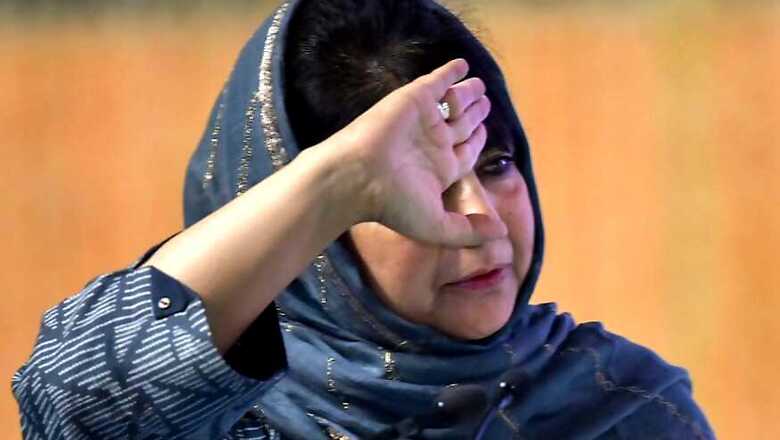
views
New Delhi: Going by the exit polls, of the six Lok Sabha seats in Jammu and Kashmir, the BJP is predicted to win two in Jammu, the Congress one in Ladakh and the National Conference (NC) all the three seats in the Valley.
The Times Now-VMR has predicted the BJP will win two seats in the northern-most state of India, while the Congress and the NC are predicted to get four seats in Lakadh and the Valley.
The exit poll has predicted a massive difference in the voting share between the two former allies — the Bharatiya Janata Party (BJP) at 30.6% and Mehbooba Mufti-led Peoples Democratic Party (PDP) at 10%.
According to the News Nation exit poll, the BJP is likely to bag 33% vote share and the Congress may secure 28% vote share. Regional parties, NC and PDP, are expected to fetch a vote share of 14% and 11%, respectively.
On the other hand, Jan Ki Baat has predicted one-two seats for the BJP in the state, while as the NC-Congress is projected to win three-four seats and the PDP is set to win one seat.
Most of the exit polls have also predicted that the Mufti-led party is likely to lose from all three seats of Kashmir.
The former chief minister is contesting from South Kashmir’s Anantnag constituency which has remained in news because of violence over the last five years.
The NC and PDP didn’t contest from Jammu fearing division of secular votes that would benefit the BJP. With exit polls showing the BJP winning both the Jammu seats, it looks like the strategy to consolidate the secular vote hasn’t worked in the region.
This was the first general election being held in what has come to be known as the post-Burhan Wani phase. Two months before voting, the Pulwama terror attack in which 40 CRPF jawans were killed further complicated the situation.
In the three seats of the Valley, elections were held in five phases. The Anantnag constituency, which consists of four south Kashmir districts of Kulgam, Pulwama, Shopian and Anantnag, voted in three phases, a first in the electoral history of the country, owing to security concerns.
The Baramulla Lok Sabha constituency consists of the three districts of north Kashmir — Kupwara, Baramulla and Bandipora — which have one end at Line of Control (LoC), the de facto border between India and Pakistan.
The competition in the north was between the National Conference and People’s Conference, which is led by separatist-turned-politician, Sajad Lone, who was an ally of the BJP in the last government of the state.
However, the overwhelming support for firebrand independent legislator Engineer Rashid was also surprising.
Apart from border skirmishes, lack of concrete bunkers and common issues like electricity and road connectivity, the major poll plank in the state was the raging debate over special status to the state under articles 370 and 35A.
The voter turnout in the Baramulla seat remained 34%, which is 3% less than the last elections, but more than what was expected.
In Srinagar constituency, elections were low key this time. First because National Conference leader Farooq Abdullah was contesting from here with no strong candidate in opposition.
Secondly, the killings in the bypolls of 2017 still weigh heavy on the electorate. Voting was peaceful in the seat which registered a meagre 14% turnout.
The real challenge was south Kashmir, where the cumulative voter turnout in the three phases remained 9%. Despite the huge deployment of forces personnel, the mood on the ground was indifference to the polls. The numbers suggest that even all the basic workers of the parties didn’t turn up for voting.
Jammu
There are two Lok Sabha seats in the Jammu province consisting of 10 districts — the Jammu constituency, which comprises the western side of the region, and the Udhampur constituency, on the eastern side.
The fight in these both seats was mainly between the BJP and Congress. To counter the BJP, National Conference and PDP supported the grand old party in Jammu.
The concern apart from the development in the Jammu constituency was over the ceasefire violations along the LoC and the International Border as most of the areas touch the turbulent line.
An interesting twist in the Jammu elections was added by BJP leader Lal Singh, who was a minister in the last PDP-BJP government before signing along with a colleague after addressing a rally in support of the Kathua rape suspects.
Singh, who has also been a Congress leader and an MP, floated his own party and contested from both the seats. Influential in the Dogra belt, Singh is believed to have cut a good share of votes.
Ladakh
World apart from the politics of Kashmir and Jammu, Ladakh, which recently was given a separate division status, is the largest Lok Sabha constituency in India in terms of area at 1,73,000 sq km.
The politics of Ladakh is divided between its two districts — Kargil in the east and Leh in the West.
The PDP and NC are supporting an Independent candidate, Sajad Kargili, who also has the support of Buddhist and Muslim organisations in the Kargil area. The Congress fielded its own candidate, while a senior party leader is contesting independently.
In 2014, the Ladakh seat was won by the BJP, but later, the MP resigned from Parliament and BJP as well.




















Comments
0 comment